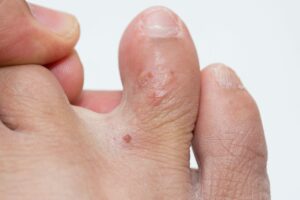Dyshidrotic Eczema
What is dyshidrotic eczema?
Dyshidrotic eczema is a skin condition that causes small blisters on the palms of hands, soles of the feet and edges of the fingers and toes. While the actual cause of dyshidrotic eczema isn’t known, it is more common in people who have another form of eczema and tends to run in families, suggesting a genetic component.
Who gets dyshidrotic eczema and why?
This common form of eczema, also called pompholyx (which means “bubble” in ancient Greek), foot-and-hand eczema, palmoplantar eczema and vesicular eczema, is found more frequently in women than in men.
Dyshidrotic eczema is most common in younger adults, typically between the ages of 20 and 40. People can have a single flare-up of dyshidrotic eczema, but it’s more common for it to come and go over long periods of time.
Metals, particularly nickel, are a common trigger. Stress can also cause a flare. Laundry detergent can cause a flare. The condition is also linked to seasonal allergies like hay fever, and to hot, humid weather. Sweaty palms can trigger the rash, as can doing a job such as hairstyling or healthcare that entails frequently getting the hands wet. Any external trigger or irritant that impacts your immune system can affect your skin, too. Hand dermatitis includes not only dyshidrotic eczema but may also refer to a wider range of skin conditions that are triggered by environmental irritants and allergens; atopic dermatitis may also lead to outbreaks of eczema along the skin of your hands.
What are the symptoms of dyshidrotic eczema?
Flares happen only on the hands and feet and usually begin with a rash of painful, deep-seated blisters called vesicles, although sometimes itching and burning sensations begin first. As blisters heal, the skin dries and often reddens and peels. This leaves it tender and dry and sometimes creates painful fissures or cracks. Skin can also become infected.
How is dyshidrotic eczema treated?
Knowing your triggers and maintaining a regular skincare routine can help prevent and manage dyshidrotic eczema flares. Helpful steps can include:
- Wash the affected skin with a mild cleanser and gently pat dry.
- Apply a heavy cream with ingredients like ceramides to help repair the skin barrier.
- Remove rings and other jewelry when you wash your hands so water doesn’t linger on you skin.
- Wash then moisturize hands or feet immediately after coming into contact with a potential trigger.
- Use stress management techniques.
- Keep fingernails short to help prevent scratching from breaking the skin.
Dermatologists can usually diagnose dyshidrotic eczema with a skin exam and medical history. Many cases improve quickly with a short course of topical corticosteroids combined with soaking or applying cool compresses to affected areas a few times a day to help dry out blisters. Because this form of eczema is sometimes linked to a fungal infection on the hands or feet, your dermatologist may prescribe an anti-fungal medication if needed.
Areas of dyshidrotic eczema are also at risk for bacterial skin infections, which can delay or prevent healing. If you develop swelling, crusting, pain or pus-filled blisters, visit your dermatologist to check for bacterial infection, which requires treatment with oral antibiotics.
When dyshidrotic eczema is severe or flares happen often, dermatologists may prescribe light therapy, topical calcineurin inhibitors (TCIs) or oral steroids. Occasionally, botulinum toxin injections are used to control the sweaty hands and feet that can trigger the condition.
What do the ecz-perts have to say?
“Although dyshidrotic eczema involves limited areas of the body, it can have a big impact on patients,” said Dr. Gil Yosipovitch, MD, professor and director of the Miami Itch Center at the Dr. Phillip Frost Department of Dermatology and Cutaneous Surgery at the University of Miami Miller School of Medicine in Florida.
“Unlike some forms of eczema, you don’t usually cover it with clothes, so it’s visible to others. It can affect social interactions — you may not want to shake hands, for example.”
“It’s very common to see emotional stress induce or exacerbate this type of eczema,” he added. “A college student may be in the midst of exams, for example, and suddenly develop blistering at the fingertips.”
Additional information about dyshidrotic eczema
People who experience contact dermatitis and atopic dermatitis may also simultaneously live with dyshidrotic eczema flares; severe cases of dyshidrotic eczema can sometimes lead to large blisters. Every individual experiences eczema differently, and the variety of treatment options can sometimes range from phototherapy, to corticosteroids like prednisone, topical steroids like methotrexate, or the daily use of topical emollients, but be sure to consult with your healthcare provider to determine the best course of treatment for your individual symptoms. Some people with eczema use patch testing with an allergist to identify possible triggers. Some forms of eczema can appear with scaly patches more similar to psoriasis. The American Academy of Dermatology has additional information on dyshidrotic eczema.


